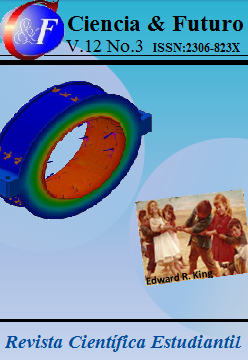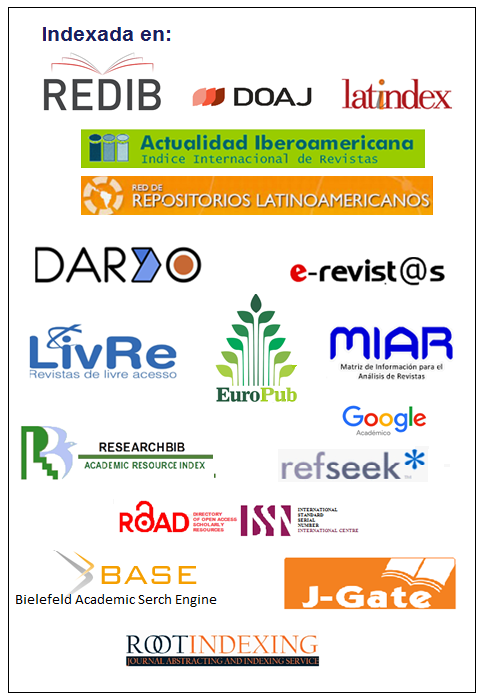Psychosocial and neuropsychological effect of blows to the head in children and adolescents
Keywords:
concussion, head trauma, sport, post-concussion.Abstract
Psychosocial and neuropsychological effect of blows to the head in children and adolescents The clinical, epidemiological, etiology, treatment, psychosocial and neuropsychological factors of sports concussion were described, as well as presenting clinical cases and research that show the effects of this injury on children and adolescents. Brain concussions appear in high-performance athletes and in recreational activities, especially in combat or collision sports.Downloads
References
ANZALONE, A.; TURNER, S.; BALEZTENA, A.; MCGUFFIN, T.; CREED, K.; JEROMIN, A.; WILSON, D.; HANLON, D.; GARRISON, C.; BLUEITT, D. Y OLIVER, J. 2021. Biomarcadores sanguíneos de conmoción cerebral relacionada con el deporte de atletas pediátricos. Revista clínica de medicina deportiva 31(3): 250-256.
AUBRY, M.; CANTU, R.; DVORAK, J.; JOHNSTON, K.; KELLY, J.; LOVELL, M. R.; MCCRORY, P.; EEUWISE, W. & SCHAMASCH, P. 2002. Summary and agreement statement of the First International Conference on Concussion in Sport. British Journal of Sports Medicine 36(1): 6–10.
BENSON, A. J. & BRUNER, M. W. 2018. How teammate behaviors relate to athlete affect cognition, and behaviors: A daily diary approach within youth sport. Psychology of Sport and Exercise 34: 119–127.
BARTH, J. T.; FREEMAN, J. R. Y BROSHEK, D. K. 2002. Mild head injury, en Encyclopedia of the Human Brain, Vol. 3. Editado por Ramachandran, V. S. San Diego, California: Academic Press. 81-92.
BLINMAN, T. A.; HOUSEKNECHT, E.; SNYDER, C.; WIEBE, D. J. & NANCE, M. L. 2009. Postconcussive symptoms in hospitalized pediatric patients after mild traumatic brain injury. Journal of Pediatric Surgery 44(6): 1223–1228.
BRASURE, M.; LAMBERTY, G. J.; SAYER, N. A.; NELSON, N. W.; MACDONALD, R.; OUELLETTE, J.; TACKLIND, J.; GROVE, M.; RUTKS, I. R.; BUTLER, M. E.; KANE, R. L. & WILT, T. J. 2012. Multidisciplinary Postacute Rehabilitation for Moderate to Severe Traumatic Brain Injury in Adults. Agency for Healthcare Research and Quality (US). Disponible en: http://www.ncbi.nlm.nih.gov/books/NBK98993/.
BROWN, D.; GRANT, G.; EVANS, K.; LEUNG, F. & HIDES, J. 2021. The association of concussion history and symptom presentation in combat sport athletes. Physical Therapy in Sport 48: 101-108. Disponible en: https://doi.org/10.1016/j.ptsp.2020.12.019.
BRUNER, M. W.; BOARDLEY, I. D. & COT, J. 2014. Social identity and prosocial and antisocial behavior in youth sport. Psychology of Sport and Exercise 15(1): 56–64. Disponible en: https://doi.org/10.1016/j.psychsport.2013.09.003.
COVASSIN, T.; ELBIN, R. J.; BEIDLER, E.; LAFEVOR, M. & KONTOS, A. P. 2017. A review of psychological issues that may be associated with a sport-related concussion in youth and collegiate athletes. Sport, Exercise, and Performance Psychology, 6: 220–229. Disponible en: https://doi.org/10.1037/spy0000105.
CHAMARD, E.; THÉORET, H.; SKOPELJA, E.N.; FORWELL, L. A.; JOHNSON, A. M.; ECHLIN, P. S.; 2012. A prospective study of physician-observed concussion during a varsity university hockey season: metabolic changes in ice hockey players. Part 4 of 4. Neurosurgical focus, 33: 4.
CHURCHILL, N. G., GRAHAM, S. J. & SCHWEIZER, T. A. 2020. Neurometabolites and sport-related concussion: From acute injury to one year after medical clearance. NeuroImage: Clinica 27: 102258. Disponible en: https://doi.org/10.1016/j.nicl.2020.102258.
DANESHVAR, D.; NOWINSKI, C.; MCKEE, A. Y CANTU, R. 2011. The Epidemiology of Sport-Related Concussion. Clin Sports Med 30.
DEAN, P. J. Y STERR, A. 2013. Long-term effects of mild traumatic brain injury on cognitive performance. Frontiers in Human Neuroscience 7(30): 1-11. 10.3389/fnhum.2013.00030.
DECH, R.; BISHOP, S. Y NEARY, P. 2019. Why exercise may be beneficial in concussion rehabilitation:A cellular perspective. Journal of Science and Medicine in Sport 22. Disponible en: https://doi.org/10.1016/j.jsams.2019.06.007.
ERLANGER, D.; SALIBA, E.; BARTH, J. T.; ALMQUIST, J.; WEBRIGHT, W. & FREEMAN, J. 2001. Monitoring resolution of postconcussion symptoms in athletics: Preliminary results of a web-based neuropsychological test protocol. Journal of Athletic Training, 36(3): 280–287.
GALETTA, K. M.; BRANDES, L. E.; MAKI, K.; DZIEMIANOWICZ, M. S.; LAUDANO, E.; ALLEN, M.; LAWLER, K.; SENNETT, B.; WIEBE, D.; DEVICK, S.; MESSNER, L. V.; GALETTA, S. L. & BALCER, L. J. 2011. The King-Devick test and sports-related concussion: Study of a rapid visual screening tool in a collegiate cohort. Journal of the Neurological Sciences 309(1–2): 34–39. Disponible en: https://doi.org/10.1016/j.jns.2011.07.039.
GRADY, M. F.; MASTER, C. L. & GIOIA, G. A. 2012. Concussion pathophysiology: Rationale for physical and cognitive rest. Pediatric Annals 41(9): 377–382. Disponible en: https://doi.org/10.3928/00904481-20120827-12.
GIZA, C. C.; HOVDA, D. A.; 2014. The new neurometabolic cascade of concussion. Neurosurgery 75(4): 24–33.
HALABI, C. 2021. Concussion. En Aminoff’s neurology and general medicine. .673-680. Disponible en: https://www.researchgate.net/publication/349525769_Concussion.
HARRIS, A.; ABOTT, K.; HUMPHREYS, D.; DALEY, M.; MOIR, M.; WOEHRLE, E.; BALESTRINI, C.; FISCHER, L.; FRASER, D. & SHOEMAKER, J. 2020. Concussion Symptoms Predictive of Adolescent Sport-Related Concussion Injury. Clinical Journal Sport Medicine 30(5).
HENRY, L. C.; TREMBLAY, S.; LECLERC, S.; KHIAT, A.; BOULANGER, Y.; ELLEMBERG, D. & LASSONDE, M. 2011. Metabolic changes in concussed American football players during the acute and chronic post-injury phases. BMC neurology 11: 105.
HORNSEY, M. J. 2008. Social identity theory and self-categorization theory: A historical review. Social and Personality Psychology Compass 2: 204–222.
JOHNSON, B.; ZHANG, K.; GAY, M.; HOROVITZ, S.; HALLETT, M.; SEBASTIANELLI, W. & SLOBOUNOV, S. 2012. Alteration of brain default network in subacute phase of injury in concussed individuals: resting-state fMRI study. Neuroimage 59: 511–518.
KROSHUS, E.; BABKES STELLINO, M.; CHRISMAN, S. P. & RIVARA, F. P. 2018. Threat, pressure, and communication about concussion safety: Implications for parent concussion education. Health Education & Behavior 45(2): 254–261.
LEVIN, H. S. & HANTEN, G. 2005. Executive functions after traumatic brain injury in children. Pediatric Neurology 33(2): 79–93.
LICKEL, B.; HAMILTON, D. L.; WIECZORKOWSKA, G.; LEWIS, A.; SHERMAN, S. J. & UHLES, A. N. 2000. Varieties of groups and the perception of group entitativity. Journal of Personality and Social Psychology 78: 223.
LIN, A.; LIAO, H.; MERUGUMALA, S.; PRABHU, S.; MEEHAN, W. & ROSS, B. 2012. Metabolic imaging of mild traumatic brain injury. Brain imaging and behavior 6: 208–223.
MCCRORY, P.; MEEUWISSE, W.; DVORAK, J.; AUBRY, M.; BAILES, J.; BROGLIO, S.; CANTU, R. C.; CASSIDY, D.; ECHEMENDIA, R. J.; CASTELLANI, R. J.; DAVIS, G. A.; ELLENBOGEN, R.; … VOS, P. E. 2017. Consensus statement on concussion in sport—The 5th international conference on concussion in sport held in Berlin, October 2016. British Journal of Sports Medicine 51(11): 838-847.
MCDONALD, C. M.; JAFFE, K. M.; FAY, G. C.; POLISSAR, N. L.; MARTIN, K. M.; LIAO, S. & RIVARA, J. B. 1994. Comparison of indices of traumatic brain injury severity as predictors of neurobehavioral outcome in children. Archives of Physical Medicine and Rehabilitation 75(3): 328–337.
MCGUCKIN, M. E.; LAW, B.; MCAULIFFE, J.; RICKWOOD, G. & BRUNER, M. W. 2016. Social influences on return to play following concussion in female competitive youth ice hockey players. Journal of Sport Behavior 39: 426–445.
MORELAND, G. Y BARKLEY, L. 2021. Concussion in Sport. Current Sports Medicine Reports, 20(10). Disponible en: https://journals.lww.com/acsm-csmr/pages/default.aspx.
MULLALY, W. 2017. Concussion. The American Journal of Medicine 130(8): Disponible en: http://dx.doi.org/10.1016/j.amjmed.2017.04.016.
PRAHARSO, N. F.; TEAR, M. J. & CRUWYS, T. 2017. Stressful life transitions and wellbeing: A comparison of the stress buffering hypothesis and the social identity model of identity change. Psychiatry Research 247: 265–275. Disponible en: https://doi.org/10.1016/j.psychres.2016.11.039.
REES, T.; HASLAM, S. A.; COFFEE, P. & LAVALLEE, D. 2015. A social identity approach to sport psychology: Principles, practice, and prospects. Sports Medicine 45: 1083–1096. Disponible en: https://doi.org/10.1007/s40279-015-0345-4.
SCHATZ, P. & ZILLMER, E. 2003. Computer-based assessment of sports-related concussion. Applied Neuropsychology 10(1): 42–47
TARLOCHAN, F. 2013. Finite Element (FE) human head models/literature review. International. Journal of Scientific & Technology Research 2: 17–31.
TOMMASONE, B. A. & VALOVICH MCLEOD, T. C. 2006. Contact sport concussion incidence. Journal of athletic training 41(4): 470.
VAGNOZZI, R.; SIGNORETTI, S.; CRISTOFORI, L.; ALESSANDRINI, F.; FLORIS, R.; ISGRÒ, E.; RIA, A.; MARZIALI, S.; MARZIALE, S.; ZOCCATELLI, G.; TAVAZZI, B.; DEL BOLGIA, F.; SORGE, R.; BROGLIO, S. P.; MCINTOSH, T. K. & LAZZARINO, G. 2010. Assessment of metabolic brain damage and recovery following mild traumatic brain injury: A multicentre, proton magnetic resonance spectroscopic study in concussed patients. Brain: A Journal of Neurology 133(11): 3232-3242.
VAGNOZZI, R.; SIGNORETTI, S.; FLORIS, R.; MARZIALI, S.; MANARA, M.; AMORINI, A. M.; BELLI, A.; DI PIETRO, V.; DʼURSO, S.; PASTORE, F. S.; LAZZARINO, G. & TAVAZZI, B. 2013. Decrease in N-acetylaspartate following concussion may be coupled to decrease in creatine. The Journal of Head Trauma Rehabilitation 28(4): 284-292.
VAGNOZZI, R.; SIGNORETTI, S.; TAVAZZI, B.; FLORIS, R.; LUDOVICI, A.; MARZIALI, S.; TARASCIO, G.; AMORINI, A. M.; DI PIETRO, V.; DELFINI, R. & LAZZARINO, G. 2008. Temporal window of metabolic brain vulnerability to concussion: A pilot 1H-magnetic resonance spectroscopic study in concussed athletes-part III. Neurosurgery 62(6): 1286-1295.
WIEBE, D. J.; COLLINS, M. W. & NANCE, M. L. 2012. Identification and validation of prognostic criteria for persistence of mild traumatic brain injury-related impairment in the pediatric patient. Pediatric Emergency Care 28(6): 498–502.
WIESE-BJORNSTAL, D.; WHITE, A.; RUSSELL, H. & SMITH, A. 2015. Psychology of sport concussions. Kinesiology Review 4(2): 169–189.
Published
How to Cite
Issue
Section
Esta obra está bajo una Licencia Creative Commons Reconocimiento-NoComercial 4.0 Internacional
La Revista Ciencia & Futuro es una revista de acceso abierto, todo el contenido está disponible gratuitamente sin cargo para el usuario o su institución. Los usuarios pueden leer, descargar, copiar, distribuir, imprimir, buscar o vincular los textos completos de los artículos, o utilizarlos para cualquier otro fin lícito, sin pedir permiso previo al editor o al autor. Todo lo anterior, de acuerdo con la definición de BOAI de acceso abierto.
Los autores que publican en esta revista están de acuerdo con los siguientes términos: Licencia Creative Commons Atribución-NoComercial permite que el beneficiario de la licencia tenga el derecho de copiar, distribuir, exhibir y representar la obra y hacer obras derivadas para fines no comerciales siempre y cuando reconozca y cite la obra de la forma especificada por el autor o el licenciante. Los autores pueden establecer por separado acuerdos adicionales para la distribución no exclusiva de la versión de la obra publicada en la revista (por ejemplo, situarlo en un repositorio institucional o publicarlo en un libro), con un reconocimiento de su publicación inicial en esta revista. Se permite y se anima a los autores a difundir sus trabajos electrónicamente (por ejemplo, en repositorios institucionales o en su propio sitio web) antes y durante el proceso de envío, ya que puede dar lugar a intercambios productivos, así como a una citación más temprana y mayor de los trabajos publicados (Véase The Effect of Open Access) (en inglés). Lo anterior debe realizarse siempre sobre el artículo ya publicado por Ciencia & Futuro.
Los autores mantienen el control sobre la integridad de sus trabajos y el derecho a ser adecuadamente reconocidos y citados.
A los editores se les otorgan derechos no exclusivos para publicar y distribuir.




